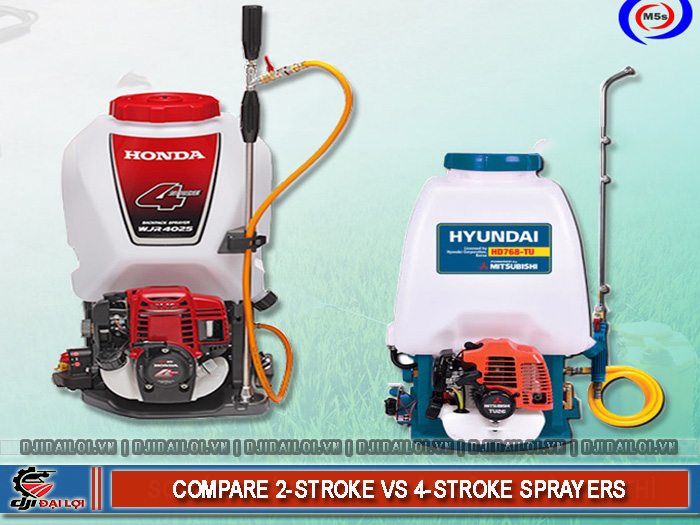
The 2-stroke pesticide sprayer is a popular agricultural tool known for its compact design, portability, and low upfront cost. A 2-stroke engine works by mixing fuel and oil in one solution, allowing the sprayer to generate high power with minimal weight. It’s a common choice for small- to medium-sized farms growing vegetables or flowers, and is sometimes compared to modern solutions like agricultural drones for wide-area spraying.
A 2-stroke engine completes a power cycle every two piston strokes, producing an explosion with each crankshaft rotation. This results in fast acceleration, high RPM, and strong spraying capability. Thanks to its simple structure, 2-stroke gasoline sprayers are lightweight, easy to carry, and require minimal maintenance.
In practice, 2-stroke sprayers are suitable for small to medium areas. They start easily and deliver consistent spray flow, though limited by small fuel tanks and moderate heat dissipation. When used for long hours, they tend to overheat and consume more fuel than 4-stroke models.
Example: Roman 2-stroke pesticide sprayer
The 4-stroke pesticide sprayer stands out for its stable engine performance and superior fuel economy. With a four-cycle combustion process, it operates smoothly, with less vibration and noise. It’s favored by farmers managing fruit trees, industrial crops, or large farms due to its durability and consistent output.
A 4-stroke engine completes four strokes - intake, compression, combustion, and exhaust - per cycle. Compared to 2-stroke engines, it has a more complex design and heavier weight, but offers smoother operation and a longer lifespan. Most 4-stroke gasoline sprayers have a separate oil reservoir for lubrication, reducing friction and wear.
In real-world use, 4-stroke sprayers are more fuel-efficient, enabling longer and more stable operation. They run quietly and are ideal for quiet environments such as greenhouses or fruit orchards. However, they start slower and require more regular maintenance.
Example: Honda GX35 4-stroke sprayer
|
Criteria |
2-stroke sprayer |
4-stroke sprayer |
|---|---|---|
|
Spraying power |
Instant, ideal for small–medium areas |
Stable, effective on large areas |
|
Fuel consumption |
Higher, requires fuel–oil mix |
Lower, uses pure gasoline |
|
Durability |
Shorter engine lifespan |
Longer-lasting, fewer breakdowns |
|
Noise and vibration |
Louder and more vibration |
Quiet, smooth operation |
|
Maintenance |
Easy, low-cost parts |
Complex, more expensive repairs |
2-stroke sprayers deliver instant power, ideal for fast spraying on moderate areas. In contrast, 4-stroke sprayers emphasize stability - capable of continuous, long-hour operation without overheating, making them suitable for rice fields or large orchards.
2-stroke engines burn more fuel since they mix oil with gasoline and complete combustion faster. Meanwhile, 4-stroke sprayers are more fuel-efficient and eco-friendly due to cleaner exhaust and optimized cycles.
4-stroke engines last longer, thanks to dedicated lubrication systems that reduce friction. Conversely, 2-stroke sprayers wear faster and require more frequent part replacements under heavy use.
2-stroke models produce more noise and vibration, which can tire the operator during long sessions. 4-stroke machines operate quietly and smoothly - ideal for quiet farms and greenhouse environments.
2-stroke sprayers are simple to maintain, with cheap and widely available spare parts. 4-stroke machines, however, demand skilled maintenance and cost about 15–30% more for parts replacement.
|
Criteria |
2-stroke sprayer |
4-stroke sprayer |
Best suited for |
|---|---|---|---|
|
Price |
Low, budget-friendly |
20–40% higher |
Small farms, limited budget |
|
Power |
Strong and fast |
Stable, long-run operation |
Vegetable gardens |
|
Fuel |
Higher consumption, oil mix required |
Fuel-efficient, no oil mix |
Large fields, rice farms |
|
Noise |
Loud and high vibration |
Quiet and smooth |
Quick spraying tasks |
|
Lifespan |
Shorter |
Long-lasting |
Professional, long-term use |
|
Maintenance |
Simple, low-cost |
Technical, costly |
Novice users |
Choose a 2-stroke sprayer - lower investment, strong short-burst power, ideal for small areas.
A 4-stroke sprayer is the best choice - continuous operation, fuel-efficient, and long-lasting.
If reducing fuel expenses and breakdowns is your priority, choose a 4-stroke gasoline sprayer. Although its purchase price is higher, the long-term cost is lower.
The difference between 2-stroke and 4-stroke pesticide sprayers lies not only in engine design but also in efficiency, durability, fuel economy, and operating cost.
Ultimately, you should weigh your usage purpose, farm size, upfront investment, and long-term maintenance cost. The right choice will save time, money, and improve pest control efficiency.
Yes. They require a fuel–oil mix, which adds to running costs. Proper mixing ensures smooth operation and reduced wear.
Typically ranges from 2,000,000–3,500,000 VND depending on brand and tank capacity.
Yes. Most last 5–7 years with proper maintenance due to independent lubrication.
Yes. Though heavier, they run smoother and quieter - manageable with shoulder straps and mid-sized tanks.
2-stroke sprayers - their simple structure and cheaper parts make maintenance straightforward, unlike the more complex 4-stroke models.